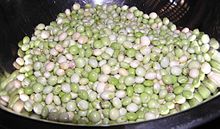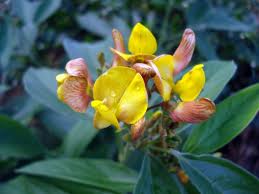The pigeon pea (Cajanus cajan), also known as Gandule bean, tropical green pea, kadios, Congo pea, gungo pea, gunga pea, fio-fio, mgb mgb , or no-eye pea, is a perennial member of the family Fabaceae.
Flowering, fruiting pea, pulse, grows to large bush or small tree, trellis, light shade – edible, perennial, firewood kindling – another great multipurpose plant variety.
The cultivation of the pigeon pea goes back at least 3,500 years.
Originating in the eastern part of the Indian peninsular and now are widely cultivated in all tropical and semitropical regions world wide. very important legume crop for dry land agriculture in the semiarid tropics, often grown as an annual, but it is a perennial and will bear quite well for 3 or 4 years before the quantity drops off. Very drought tolerant when established. The dry beans keep very well and are a staple food world wide being used in a variety of ways and also ground into flour. However the green fresh beans are the preferred way to eat them, as they flavour is exquisite and the texture smoother. An additional flavour can be obtained by first sprouting the pigeon pea and then cooking, this also increases protein levels – fresh young pods are eaten as a vegetable in dishes such as sambar, also the young shoots and leaves are cooked and eaten.
Being a legume, the pigeon pea enriches soil through symbiotic nitrogen fixation and is grown in combination as a companion plant with, corn, beans, peanuts, sorghum and other cereal crops. Making the land they are grown on very productive and useful. Where mechanization is available pigeon pea is being consumed by animals and now the most essential ingredient of animal feed in West Africa. It is also a very important green manure crop and raises the nutrient level of the soil and has been used for fertilizer for thousands of years – providing around 40 kg nitrogen per hectare.
In the home garden as well as the bountiful crop of peas to eat you can cut them back. This increases nitrogen fixing as the root nodules release nitrogen which makes it available to other plants. The prunings are used as mulch increasing nitrogen to the soil as they break down. The open canopy allows plenty of light underneath to grow lots of things like lettuce, parsley, The bees love the flowers which range in a variety of colours (cream, yellow, red) – and are attracted to the garden by them. The sturdy frame of the tree can be used to grow other creepers on – like tomatoes no need to stake and they’re fertilized at the same time. The wood makes great kindling and burns hot. The sizes of the plant ranges from small bushes to large tree like and sturdy plants.
This variety is large and grows a bigger stronger trunk each year, but still not always enough to cope with the weight of the massive amounts of peas pods it grows and can crack and break under the stain especially in high winds.
Easy to grow, a pleasure to look at and a yummy to eat. And has been know to flower and seed twice in the same year.
If all plants were this beneficial life would be simple.
These items are located in Kyogle, NSW Australia and can be purchase when available from the link below.




